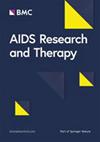探索多形红斑与艾滋病毒感染之间的关联:一些机制和影响
IF 2.1
4区 医学
Q3 INFECTIOUS DISEASES
引用次数: 0
摘要
多形性红斑(EM)是一种免疫介导的皮肤黏膜疾病,其特点是对传染源和某些药物的抗原刺激产生超敏反应。最常见的与多形性红斑有关的感染性病原体包括单纯疱疹病毒(HSV)和肺炎支原体。据报道,引发EM的其他传染病包括人类免疫缺陷病毒(HIV)感染和几种机会性感染。尽管艾滋病毒感染者的EM发病率有所上升,但人们对艾滋病毒感染者易患EM的直接和间接机制并不十分了解。反过来,这也使得诊断和管理艾滋病病毒感染者的EM成为一项艰巨的任务。艾滋病病毒感染者很容易感染已知可诱发EM的微生物,如HSV、结核分枝杆菌、苍白螺旋体、组织胞浆菌病和许多其他传染性病原体。虽然已知艾滋病病毒会感染 CD4 + T 细胞,但它也会直接与口腔和生殖器粘膜的上皮细胞结合,导致 CD8 + T 细胞对上皮细胞的反应失调。由于 CD8 + T 细胞的过度激活,当 CD8 + T 细胞识别到上皮细胞上的病毒颗粒时,艾滋病病毒感染也可能直接引发 EM。CD8 + T 细胞的超活化与药物超敏反应中观察到的情况类似。因此,抗逆转录病毒药物与EM之间的关系已得到充分证实。这包括对艾滋病毒感染者使用其他药物来控制机会性感染。因此,艾滋病病毒感染者可能同时存在多种诱发因素。本文重点阐述了艾滋病病毒感染在EM发病中可能扮演的直接和间接角色,以及在管理艾滋病病毒感染者时出现的临床困境。这些患者可能需要额外的药物来控制机会性感染,而许多机会性感染也可能诱发导致EM的超敏反应。本文章由计算机程序翻译,如有差异,请以英文原文为准。
Exploring the association between erythema multiforme and HIV infection: some mechanisms and implications
Erythema multiforme (EM) is an immune-mediated mucocutaneous condition characterized by hypersensitivity reactions to antigenic stimuli from infectious agents and certain drugs. The most commonly implicated infectious agents associated with EM include herpes simplex virus (HSV) and Mycoplasma pneumoniae. Other infectious diseases reported to trigger EM include human immunodeficiency virus (HIV) infection and several opportunistic infections. However, studies focusing on EM and human immunodeficiency virus (HIV) infection are scarce. even though the incidence of EM among HIV-infected individuals have increased, the direct and indirect mechanisms that predispose HIV-infected individuals to EM are not well understood. In turn, this makes diagnosing and managing EM in HIV-infected individuals an overwhelming task. Individuals with HIV infection are prone to acquiring microorganisms known to trigger EM, such as HSV, Mycobacterium tuberculosis, Treponema pallidum, histoplasmosis, and many other infectious organisms. Although HIV is known to infect CD4 + T cells, it can also directly bind to the epithelial cells of the oral and genital mucosa, leading to a dysregulated response by CD8 + T cells against epithelial cells. HIV infection may also trigger EM directly when CD8 + T cells recognize viral particles on epithelial cells due to the hyperactivation of CD8 + T-cells. The hyperactivation of CD8 + T cells was similar to that observed in drug hypersensitivity reactions. Hence, the relationship between antiretroviral drugs and EM has been well established. This includes the administration of other drugs to HIV-infected individuals to manage opportunistic infections. Thus, multiple triggers may be present simultaneously in HIV-infected individuals. This article highlights the potential direct and indirect role that HIV infection may play in the development of EM and the clinical dilemma that arises in the management of HIV-infected patients with this condition. These patients may require additional medications to manage opportunistic infections, many of which can also trigger hypersensitivity reactions leading to EM.
求助全文
通过发布文献求助,成功后即可免费获取论文全文。
去求助
来源期刊

AIDS Research and Therapy
INFECTIOUS DISEASES-
CiteScore
3.80
自引率
4.50%
发文量
51
审稿时长
16 weeks
期刊介绍:
AIDS Research and Therapy publishes articles on basic science, translational, clinical, social, epidemiological, behavioral and educational sciences articles focused on the treatment and prevention of HIV/AIDS, and the search for the cure. The Journal publishes articles on novel and developing treatment strategies for AIDS as well as on the outcomes of established treatment strategies. Original research articles on animal models that form an essential part of the AIDS treatment research are also considered
 求助内容:
求助内容: 应助结果提醒方式:
应助结果提醒方式:


